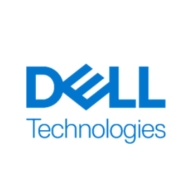


Dell PowerMax and Hitachi VSP E Series are leading storage solutions in the enterprise segment. Dell PowerMax holds an advantage due to its comprehensive integration and high-performance analytics.
Features: Dell PowerMax offers reliability, scalability, and high-performance with NVMe back-ends and advanced analytics. Hitachi VSP E Series delivers strong performance, particularly in handling transactional workloads, all-flash capabilities, and user-friendly automation features.
Room for Improvement: Dell PowerMax could improve in user management tools, end-to-end NVMe implementation, and reporting analytics. Hitachi VSP E Series might benefit from a more unified storage solution and increased marketing efforts for enhanced visibility.
Ease of Deployment and Customer Service: Dell PowerMax provides extensive technical support with some regional inconsistencies, while Hitachi VSP E Series offers intuitive deployment with room for enhancing user support further.
Pricing and ROI: Dell PowerMax is a high-cost investment with strong ROI through performance efficiencies, whereas Hitachi VSP E Series, also costly, focuses on enterprise-level performance. Both solutions offer comparable pricing, significantly shaped by their feature sets.
By opting for the gold subscription every three years, you get a free upgrade to the latest controller release.
If you wait more than seven years to buy another one, you get a return on your investment.
During a DCDR setup and migration from VMAX to Dell PowerMax, what was planned as a two-day downtime was completed in just three to four hours.
The performance metrics or benchmarks I use to measure success with Dell PowerMax include uptime as well as our response times on our platforms, both of which are exactly where we want them to be, which is five nines and as fast as possible.
My client has seen significant ROI since the install, and when you don't go down, that's an ROI in and of itself.
Return on investment depends on the use case, especially for workloads demanding high IOPS.
We also had one outage where a controller of one of the products had failed and had to be replaced on-site.
Customers always have their issues resolved promptly.
Pure has good storage.
I would rate Dell PowerMax support as a ten, as I have never had an issue with Dell support as it relates to this product.
ProSupport Next Business Day offers part replacement within four hours for data leaks.
Dell support for Dell PowerMax is exceptional, rating a perfect 10 out of 10.
The support and AI-driven initiatives are well-suited for accommodating specific workloads like AI and storage for transactional workloads.
If the call reaches a senior engineer, then the support is quite good.
It is highly scalable.
It is suitable for both medium-sized and enterprise businesses.
It hasn't broken down anytime in the last six to seven years, despite hurricanes, earthquakes, and power outages.
Scalability is not an issue.
Dell PowerMax is good for enterprises, and it also depends on how much workload you're going to bring in on Dell PowerMax in terms of performance and how many users are going to use the database you're hosting.
PowerScale is better suited for AI and overall buzz solution currently.
These products are highly scalable, offering excellent compute, memory, and storage scalability.
The product is easy to scale, although it is expensive.
During the eight years, there have been no problems such as hardware failure or stopping.
I would rate the stability of the solution as a ten out of ten.
I would rate the stability of the product at seven out of ten.
These patches can be applied on the fly without requiring software upgrades or system downtime.
I would rate it nine out of ten since there are no required downtimes, even during firmware upgrades.
There has been no downtime with Dell PowerMax; it's been extremely reliable, easy to manage, easy to upgrade, and trustworthy as we've upgraded over the years from one version to another.
There have been no known glitches or performance issues.
We would appreciate a built-in transparent failover in the next release to eliminate the need for a separate metro cluster.
I'm eagerly anticipating the roadmap's promise of introducing multiple controllers, which could significantly boost scalability and resilience.
We mostly rely on long-term releases. We don't need the most up-to-date features, but we need a reliable environment.
Compared to competitors such as NetApp, which integrates with public cloud hyperscalers (GCP, Azure, AWS), Dell PowerMax lacks in this aspect.
Dell can assist by providing plug-and-play integrated templates that allow customers to drag, drop, modify, and connect with any target system for generating snapshots without logging into the storage directly.
Dell PowerMax NVMe is very reliable storage and cannot experience downtime.
I recommend creating one product for unified use, like other manufacturers, which includes both block and file storage in one platform.
Hitachi is quite expensive, and small to medium-sized organizations usually do not purchase it.
While the prices may be higher than those of other vendors, we see it as a market leader with benefits.
The support can be a bit pricey, but the solution is more cost-effective than anything else out there.
I would give it a nine out of ten in terms of costliness.
The higher cost compared to other vendors is justified by additional features, vendor-managed upgrades, and superior support services.
It is the best choice for large projects in terms of price and features compared to midrange solutions.
The price is starting from $500,000.
Hitachi is generally expensive, providing products designed for enterprise customers like banks with transactional workloads.
The solution is expensive, which can be considered a con.
Pure Storage has signature security technology, which cannot be deleted, even if you are an administrator.
The platform's robust features include excellent sustainability tracking, and a comprehensive dashboard offering insights into IOPS, bandwidth, performance, and virtual activities.
Its data compression feature is the best that we have ever seen.
NVMe provides additional fast cache, similar to random access memory (RAM), which improves overall system performance and read/write experience for users.
Dell PowerMax NVMe is very supportive of our operational growth since we require daily performance from our core banking systems and need to facilitate data movement efficiently.
The key benefits of using Dell PowerMax, quantified in terms of saved hours and saved costs, is having one single platform that provides functionality to all of our internal customers.
Hitachi offers this twenty-four by seven without needing downtime.
The Hitachi VSP E Series is all-flash storage, so it is fast.
| Product | Market Share (%) |
|---|---|
| Dell PowerMax | 9.1% |
| Pure FlashArray X NVMe | 3.2% |
| Hitachi VSP E Series | 2.4% |
| Other | 85.3% |



| Company Size | Count |
|---|---|
| Small Business | 15 |
| Midsize Enterprise | 11 |
| Large Enterprise | 12 |
| Company Size | Count |
|---|---|
| Small Business | 17 |
| Midsize Enterprise | 16 |
| Large Enterprise | 54 |
Pure Storage FlashArray//X is the world’s first enterprise-class, all-NVMe flash storage array. It represents a new class of storage – shared accelerated storage, which is a term coined by Gartner – that delivers major breakthroughs in performance, simplicity, and consolidation.
PowerMax leads in mission-critical enterprise storage with advanced architecture and AI-driven automation, ensuring secure and efficient IT optimization. Its multi-node NVMe scale-out framework delivers unmatched performance and consolidation, backed by Dell’s Future-Proof Program.
PowerMax is renowned for its robust reliability, performance, and efficient data reduction capabilities. Users benefit from its NVMe architecture, aiding significant scalability and cost efficiency through effective deduplication and compression. Unisphere simplifies management, while CloudIQ provides enhanced monitoring. With high availability and strong IOPS capabilities, PowerMax effectively manages demanding workloads and ensures seamless operations. Its compact design and increased storage capacity enhance user experience, particularly with easy maintenance and robust performance.
What are the key features of PowerMax?Dell PowerMax is predominantly employed in mission-critical applications such as SQL, Oracle databases, ERP systems, and high transactional environments. Healthcare, finance, and e-commerce sectors leverage its high performance, scalability, and NVMe technology for low latency and redundancy. It is adept in storage consolidation, data analytics, and disaster recovery.
Hitachi VSP E Series offers an advanced storage solution designed for enterprises seeking scalability and performance. It is suitable for a range of applications, providing reliability and efficiency to meet demanding IT environments.
Hitachi VSP E Series is designed to enhance storage capabilities with robust features catering to needs such as data management, storage optimization, and system versatility. This series integrates seamlessly within IT infrastructures, offering improved data protection and resource management. Its enhanced storage architecture ensures data integrity while supporting high data loads efficiently, making it a go-to choice for enterprises requiring high-performance storage systems.
What are the most valuable features of Hitachi VSP E Series?Hitachi VSP E Series is widely implemented in industries such as finance, healthcare, and manufacturing, where data integrity and speed are crucial. Its ability to integrate with existing IT frameworks makes it a valuable addition to businesses aiming to streamline data processes while maintaining high standards of data protection and system reliability.
We monitor all NVMe All-Flash Storage Arrays reviews to prevent fraudulent reviews and keep review quality high. We do not post reviews by company employees or direct competitors. We validate each review for authenticity via cross-reference with LinkedIn, and personal follow-up with the reviewer when necessary.